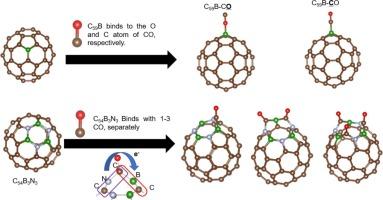Evaluating the detection potential of C59X as well as C54B3N3 for the CO molecule from DFTB view
IF 5.1
3区 材料科学
Q2 MATERIALS SCIENCE, COATINGS & FILMS
引用次数: 0
Abstract
The structural and electronic attributes of C59X-CO (X = Al, B, N, P, and Si) and C54B3N3-nCO (n = 1–3) were scrutinized through self-consistent charge density functional tight-binding computations. Analysis of the calculated adsorption energies and net charge-transfer values reveals that the CO molecule exhibits a more robust interaction with B-doped fullerenes C59B than with those doped with Al, N, P, or Si. In C54B3N3 configuration, the C atom of CO aligns perpendicularly to the N atom, and with the B atom's assistance, the formation of multiple B-C-N bond pairs is feasible, contingent upon the quantity of adsorbed CO molecules. Furthermore, it is observed that the electronic properties of both C59B and C54B3N3 demonstrate heightened sensitivity to CO molecules, attributed to a notable reduction in their energy gaps. In addition, the hetero-fullerene C54B3N3, abundant in B and N atoms, enhances the capability for CO gas detection.

从DFTB的角度评价C59X和C54B3N3对CO分子的检测潜力
C59X-CO (X = Al, B, N, P, Si)和C54B3N3-nCO (N = 1-3)的结构和电子属性通过自洽电荷密度函数紧密结合计算得到。计算的吸附能和净电荷转移值分析表明,CO分子与b掺杂的富勒烯C59B的相互作用比与Al, N, P或Si掺杂的富勒烯C59B的相互作用更强。在C54B3N3构型中,CO的C原子与N原子垂直排列,在B原子的辅助下,形成多个B-C-N键对是可行的,这取决于吸附CO分子的数量。此外,我们还观察到C59B和C54B3N3的电子性质对CO分子表现出更高的敏感性,这是由于它们的能隙显著减小。此外,富含B和N原子的杂富勒C54B3N3增强了CO气体的检测能力。
本文章由计算机程序翻译,如有差异,请以英文原文为准。
求助全文
约1分钟内获得全文
求助全文
来源期刊

Diamond and Related Materials
工程技术-材料科学:综合
CiteScore
6.00
自引率
14.60%
发文量
702
审稿时长
2.1 months
期刊介绍:
DRM is a leading international journal that publishes new fundamental and applied research on all forms of diamond, the integration of diamond with other advanced materials and development of technologies exploiting diamond. The synthesis, characterization and processing of single crystal diamond, polycrystalline films, nanodiamond powders and heterostructures with other advanced materials are encouraged topics for technical and review articles. In addition to diamond, the journal publishes manuscripts on the synthesis, characterization and application of other related materials including diamond-like carbons, carbon nanotubes, graphene, and boron and carbon nitrides. Articles are sought on the chemical functionalization of diamond and related materials as well as their use in electrochemistry, energy storage and conversion, chemical and biological sensing, imaging, thermal management, photonic and quantum applications, electron emission and electronic devices.
The International Conference on Diamond and Carbon Materials has evolved into the largest and most well attended forum in the field of diamond, providing a forum to showcase the latest results in the science and technology of diamond and other carbon materials such as carbon nanotubes, graphene, and diamond-like carbon. Run annually in association with Diamond and Related Materials the conference provides junior and established researchers the opportunity to exchange the latest results ranging from fundamental physical and chemical concepts to applied research focusing on the next generation carbon-based devices.
 求助内容:
求助内容: 应助结果提醒方式:
应助结果提醒方式:


